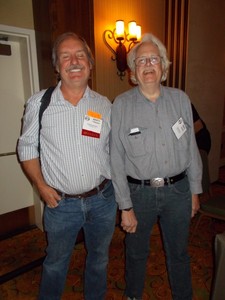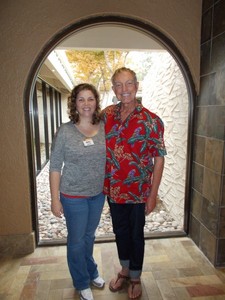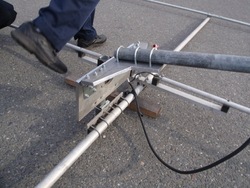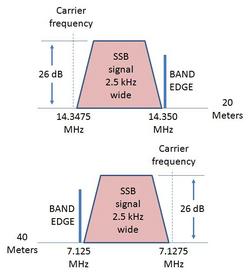 October 24, 2012 Editor: Ward Silver, NØAX | ||||||||
IN THIS ISSUE
NEW HF OPERATORS - THINGS TO DO No question about it - you've been practicing for a while and you have gotten pretty savvy about operating in HF contests. Now the Big Show is starting! This weekend is the CQ WW SSB contest - arguably the biggest radio contest of all. The ARRL CW Sweepstakes runs the following weekend - the oldest domestic contest. Those will limber you up for Sweepstakes Phone and CQ WW CW later in the month! BULLETINS November is a busy, busy contest month. With the new, improved, shorter log submission periods, it will be easy to overlook sending in a log. Make sure you submit your log before the next contest rolls around! Don't forget about the new Ontario sections (ONE, ONN, ONS, and GTA) in November's ARRL Sweepstakes that raise the Clean Sweep bar to 83. The W1AW 160 meter signal has been off the air recently due to antenna damage but is due to be restored shortly when a contractor replaces the antenna on the 24th of October. (Thanks, Don WD8DSB and W1AW Chief Operator, Joe NJ1Q) BUSTED QSOS Ed WØYK is the Director of CQ WW RTTY and CQ WPX RTTY contests. K5ZD manages only the CQ WW DX contests - CW and SSB. (Thanks, Doug KR2Q) The Cheesebits article referenced in the previous issue was authored by W3CMP, not W3CMF. (Thanks, Phil K3TUF) The ballpoint pen invented for NASA was the Fisher space pen that was specially pressurized to work in zero gravity. (Thanks, Walt N2IK) CONTEST SUMMARY Complete information for all contests follows the Conversation section Oct 27-28
Nov 3-4
VHF+ contesters will be glad to know that the Lunar-Link amplifier business has been acquired from the estate of the late Steve Powlishen K1FO. According to Steve Simons W1SMS, the business will immediately be known as "Lunar-Link International" and will offer the same high quality legal limit output VHF / UHF linear amplifiers, accessories, technical support, repairs and, replacement parts as in the past. Steve's partner, Lou Parascondola W1QJ states that new product orders are now being accepted for delivery starting in the first quarter of 2013. Are you ready for the CQ World Wide Contest? Part of getting ready is to read the rules and there are some new rules this year. All online records and scores have been updated, too. You can now submit your CQWW log on via a web site with instant feedback on any formatting errors. There's a blog for late-breaking announcements, too. (Thanks, CQ WW Director, Randy K5ZD)
Another part of getting ready is to be sure you have the current data files that help your logging software tell who's who and where they are. Jim AD1C has updated the CTY files as of 22 October. These files contain information that links prefixes (and sometimes call sign) to zone and other data. There are links to popular logging software at the top of the home page. Another popular software tool is known as "Super Check Partial" or SCP and new databases of calls for both CW/Phone and Digital contesting are now available from Bob WA1Z. More than 44,000 calls are contained in the CW/Phone file and nearly 12,000 for digital! Another update will be released prior to the CW weekend of CQ World Wide at the end of November. Contest rental stations have been available for years and years - every type of station from primitive cabins to fully-featured turn-key stations. Remote Ham Radio is now making the same access available over the Internet on a subscription basis. Whenever you are operating remote, remember to abide by all of the rules and regulations in the country from which the transmitter operates, along with any rules about remote operation for the contest you choose to enter. (Thanks, Jim N7US) Here's one way to keep from moving your hands off the keyboard while operating - change your hands into a keyboard!
The real-time score reporting sites, Getscores and the Online Contest Score Server (a.k.a. cqcontest.ru) are attracting more participants every weekend. Using these sites to watch the changing scores of other stations facilitates challenges, local competition, "contests within a contest", and can be a powerful motivator to maximize the all-important BIC (Butt In Chair) metric! The Online Contest Score Server was also used officially for real-time scoring in this year's Scandinavian Activity Contest's "National Team Contesting Trial". In addition to the scores, the site has the ability to embed audio and video streams from the stations. (Thanks, Kim OH6KZP and others) From the ARRL Propagation Bulletin by Tad K7RA, we learn that the NASA solar cycle prediction has been revised slightly since last month. You may recall that the predicted peak was moved recently from Spring to Fall 2013, and now the predicted peak has gone down one point, from a smoothed sunspot number of 76 to 75. Web Site of the Week - We take it for granted these days that power from the utility grid is ac. It wasn't always so and you can find out more about the clash of the titans - Tesla and Edison - that determined whether dc or ac would eventually prevail. WORD TO THE WISE The time to update your logging software is today...NOT FRIDAY AFTERNOON BEFORE THE CONTEST! Before you get too wrapped up in preparations for the upcoming contests, why not take a few minutes to send a photo and story to the sponsor of your last contest? CQ WW RTTY Director, Ed WØYK encourages you to send photos and stories about your operation. Writeup authors are always looking for material! The webinar hosted by new CQ World Wide Director, Randy K5ZD was recorded and can be viewed online. Randy's PowerPoint slides have also been posted for you to download and view. Hey, I think this Internet thing may be catching on... (Thanks, Ken K4ZW) How about a little "wayback machine"with this 20-minute professional WRTC video from 1990 in Seattle? Thanks to Stu N7ZZ for converting it to digital for us to enjoy. (Thanks, Danny K7SS) Watch for the mail carrier - 2011 Sweepstakes plaques have been shipped out and will be arriving in time to put them up in the shack before the contest! (Thanks, ARRL Contest Branch Manager, Sean KX9X) August NAQP CW preliminary results are now online. (Thanks, NAQP CW Manager, Chris KL9A) The results for the Stew Perry Warmup are now posted even though the contest ended Sunday! As more logs come in - the results will be updated. (Thanks, Tree N6TR)
Official results for the 2012 EU HF Championship are now ready on the Slovenian Contest Club website having been verified by the SCC Contest Committee. All UBN reports are publicly available as usual, too. Everyone can print their own certificate online directly from the results. (Thanks, SCC Contest Manager, Robert, S57AW) IOTA Contest Manager, Don G3XTT writes, "Provisional results for the 2012 IOTA Contest were made available last week, and all entrants should have received an email from the robot with a link to the results and to their personal UBN. If you entered and have not received this information, please email me as soon as possible. We are allowing a short time for appeals and will go "final" with the results (including making the URL available to everyone) probably in mid-November." OPERATING TIP CQ WW RTTY Director, Ed WØYK, shares the log submission issues experienced by all contest sponsors. "It is apparent that many people do not read the robot email reply they receive. At the bottom of that email, the robot lists the format errors in the log. If you don't understand what the robot is telling you, then simply compare that specific QSO line with the format specified on the Logs web page. The problem should be obvious.
"Major logging programs like Win-Test, N1MM Logger and WriteLog all create compliant Cabrillo files ... IF you enter your data correctly. For example, if you enter your sent exchange as 'CA 03' in N1MM Logger (which is backwards from the required order for CQ WW RTTY), it will come out in that (incorrect) order in the Cabrillo file. "You can easily edit your Cabrillo file with a text editor. Since is it common to add, change or move the same parameter field in every QSO line, a column editor is invaluable. I recommend the freeware Crimson Editor." So read that robot message! If it tells you there is something wrong with your log - do something about it and resubmit it. Double- and triple-check your operating category and all of the information for your station. Once you have a happy robot and you are a happy log submitter - save the confirming message in an easy-to-find location. My email software has a folder named "Contest Log Submissions" for all of my log submission confirmation messages. It's easy and helps avoid the dreaded "forgot to send in my log" disease. We spend hours and hours (and hours) driving our cars - almost as many as we spend driving our radios. Those seats are pretty comfy - maybe some spare seats could be converted into a good shack chair with some adjustment of the table height and equipment placement. Maybe you could replace the tuning knob with a steering wheel?
Episode #42 of Chat With The Designers is about Homebrewing VHF/UHF Antennas illustrates examples of antennas for getting on 6m, 2m and 70cm (440 MHz). Get ready for the ARRL's January VHF+ Contest now! The "whiteboard material" is online and you can watch live and archived presentations, too. (Thanks, George N2APB and Joe N2CX) When you need a little more "oomph" for a heavy job, Dan KØDAN suggests, "Another improvised 'leverage amplifier' is a large tire iron used to mount/unmount truck tires...about 5' long made of really hard 3/4" steel. It does NOT bend, and has a nice tapered lip on it for where it's supposed to pry the tire rubber on/off the wheel rim." Woof! Switchmode power supplies are not the mysterious beasties we may think - with the right design tools, building them is easy. Try the Texas Instrument's "Simple Switchers" web site for an example. A good project is building a little dc-to-dc converter to change 12 V into the 28 V needed to operate surplus aircraft relays. Don't forget the input and output filtering! Making a PC board for power distribution looks simple but how do you know if the traces are wide and heavy enough for the load? It's pretty easy to tell when they weren't by using your olfactory senses. Here's an online calculator for safe PC board current that goes up to 35 A and will help minimize the chance of you saying, "Something smells hot..."
At a recent special event station setup, KL7VIC installed a hinge assembly that allows installation of a Yagi at ground level on a tilted-over tower without bending the elements. The assembly consists of two steel plates connected together with high-quality barn door hinges (see photo at right). Plate A is attached directly to the mast that is mounted in the rotator. Plate B is attached to Plate A with hinges, free to hang perpendicularly to Plate A when the tower is horizontal as in the photo. A short stub mast installed on plate B holds the Yagi boom by its normal boom-to-mast mount. While the tower is raised from horizontal the Yagi elements stay level all the way up as Plate B folds toward Plate A and the main mast. (Thanks, Rich KL7RA) Technical Web Site of the Week - Software-defined radio is rapidly approaching a tipping point where it becomes so affordable it will start crowding out traditional radio architectures. For example, this Slashdot story notes that at the ToorCon hacker conference in San Diego, Michael Ossmann of Great Scott Gadgets revealed a beta version of the HackRF Jawbreaker, It can both read and transmit signals from 100 MHz to 6 GHz. At Ossmann's target price of $300, the versatile, open-source devices would cost less than half as much as currently existing software-defined radios with the same capabilities. The Defense Advanced Research Projects Agency (DARPA) pitched in $200,000 last February as part of its Cyber Fast Track program. Living On the Edge (This item was originally published in the 27 Oct 2010 issue, just before CQ WW SSB, and its message is just as important today - do you know where your sidebands are?) With this weekend's CQ World Wide SSB Contest coming up and the 40 meter band allocations having evolved rapidly over the past few years, it's worth taking a few minutes to review some do's and don'ts, particularly for US operators. First, the lower edge of the US phone band is 7.125 MHz - not 7.100 MHz. The requirement is for you to keep your signal above 7.125 - all of it. If you are using LSB, the frequency display of your radio shows the carrier frequency and that has to be high enough to keep the sidebands of your signal inside the phone band. What does that mean? According to the FCC in Part 97.3a, everything stronger than 26 dB below the mean power of the signal counts as the signal's bandwidth.
Without getting into a huge derivation of carrier suppression and the effects on bandwidth of audio and RF compression and distortion, let's just say that you should tune no lower than 7.1275 or 7.128 MHz to be sure of "coloring inside the lines." I'm sure some enterprising contest station outside the US will set up shop with a carrier frequency of 7.125 MHz, but just don't call them. If you have a connection to the spotting network, you can always post a spot that says, "XYØZZ 7.125 Not Legal for US Phone Band" and perhaps they (and those calling) will see it and move. A similar problem over the past couple of years has been stations at the top end of 20 meters with their USB carrier frequency above 14.3475 - you're out of the band, folks! Again, just don't call them - these are not the usual frequencies for rare stations. Another "gotcha" is caused by jumping to that freshly posted spot and giving your call without looking closely at the frequency. DX stations can operate well below 7.125 MHz, 14.150 MHz, and 21.200 MHz - don't call them there! In every contest, you can hear a steady stream of US stations well outside the US band who should know better. If you can program your radios not to transmit outside the US segments or set up your spotting network filters or logging program not to tempt you with out-of-band spots, do so. That way, in the heat of battle, you won't make a mistake. Or be tempted to "make a mistake." Finally, before sending in your log - make sure it states the right category for your entry. If you receive ANY spots from the spotting networks by any means, you must enter in the Single-Operator, Assisted category (SOA). (This is the Unlimited category in most ARRL contests.) Most logging programs now automatically connect to the Internet and then to a spotting network, so you have to disable that feature if you are going to enter the unassisted Single-Operator category. The current versions of N1MM logging software now assume a default of SOA for Single-Op entrants, so be sure and check when you set up the software. As you get ready for radiosport's Big One, remember to play nice. Have fun, definitely, but be sure to set good examples for good operating and clean signals. The world does listen - especially when you're living on the edge! 24 October - 6 November 2012 An expanded, downloadable version of QST's Contest Corral in PDF format is available. Check the sponsor's Web site for information on operating time restrictions and other instructions. HF CONTESTS ARRL November Sweepstakes--CW, from Nov 3, 2100Z to Nov 5, 0300Z. Bands (MHz): 1.8-28. Exchange: Serial, category, call, check, ARRL/RAC sec. Logs due: Nov 20. Rules SKCC Weekday Sprint--CW, from Oct 24, 0000Z to Oct 24, 0200Z. Monthly on the fourth Tuesday local time. Bands (MHz): 1.8-28, 50. Exchange: RST, S/P/C, name, SKCC number. Logs due: 2 days. Rules CQ World Wide SSB Contest--Phone, from Oct 27, 0000Z to Oct 28, 2359Z. Bands (MHz): 1.8-28. Exchange: RS and CQ zone. Logs due: 5 days. Rules SNS and NS Weekly Sprints--CW,Digital, from Nov 2, 0200Z to Nov 2, 0300Z. Weekly on Thursday evenings local time. Bands (MHz): 1.8-14. Exchange: Serial, name, and S/P/C. Logs due: 2 days. Rules IBM QSO Party--Phone,CW,Digital, from Nov 3, 0000Z to Nov 3, 2400Z. Bands (MHz): 3.5-28. Exchange: Serial, name, country, continent, and US state. Logs due: 60 days. Rules Ukranian DX Contest--Phone,CW, from Nov 3, 1200Z to Nov 4, 1200Z. Bands (MHz): 1.8-28. Exchange: RST and serial or Ukraine oblast. Logs due: 30 days. Rules OK1WC Memorial Contest--Phone,CW, from Nov 3, 1600Z to Nov 3, 1659Z. First through fourth Monday of each month; see website for bands. Bands (MHz): 3.5, 50, 144. Exchange: RS(T) and serial. Logs due: 7 days. Rules Radio Club of America QSO Party--Phone, from Nov 3, 1700Z to Nov 4, 0500Z. Bands (MHz): 3.5-21. Exchange: RST, QTH, name, equipment. Rules Collegiate ARC Championship--CW, from Nov 3, 2100Z to Nov 5, 0300Z. Bands (MHz): 1.8-28. Exchange: See ARRL Sweepstakes. Logs due: Nov 20. Rules DARC 10-Meter Digital "Corona"--Digital, from Nov 4, 1100Z to Nov 4, 1700Z. Bands (MHz): 28. Exchange: RST and serial. Logs due: 2 weeks. Rules ARS Spartan Sprint--CW, from Nov 6, 0200Z to Nov 6, 0400Z. Bands (MHz): 3.5-28. Frequencies (MHz): Monthly on the first Monday evening local time. Exchange: RST, S/P/C, and power. Logs due: 2 days. Rules VHF+ CONTESTS ARRL EME Contest--Phone,CW,Digital, from Nov 3, 0000Z to Nov 4, 2359Z. Bands (MHz): 50-1296. Exchange: Call signs, sig rpt, acknowledgement. Logs due: Jan 1. Rules SKCC Weekday Sprint--CW, from Oct 24, 0000Z to Oct 24, 0200Z. Monthly on the fourth Tuesday local time. Bands (MHz): 1.8-28, 50. Exchange: RST, S/P/C, name, SKCC number. Logs due: 2 days. Rules OK1WC Memorial Contest--Phone,CW, from Nov 3, 1600Z to Nov 3, 1659Z. First through fourth Monday of each month; see website for bands. Bands (MHz): 3.5, 50, 144. Exchange: RS(T) and serial. Logs due: 7 days. Rules LOG DUE DATES 24 October - 6 November 2012
ARRL Information Click here to advertise in this newsletter. Your One-Stop Resource for Amateur Radio News and Information ARRL membership includes QST, Amateur Radio's most popular and informative journal, delivered to your mailbox each month. Subscribe to NCJ - the National Contest Journal. Published bimonthly, features articles by top contesters, letters, hints, statistics, scores, NA Sprint and QSO Parties. Subscribe to QEX - A Forum for Communications Experimenters. Published bimonthly, features technical articles, construction projects, columns and other items of interest to radio amateurs and communications professionals. Free of charge to ARRL members: Subscribe to The ARRL Letter (weekly digest of news and information), the ARES E-Letter (monthly public service and emergency communications news), Division and Section news -- and much more! ARRL offers a wide array of products to enhance your enjoyment of Amateur Radio. Visit the site often for new publications, specials and sales. Donate to the fund of your choice -- support programs not funded by member dues! Reprint permission can be obtained by sending email to permission@arrl.org with a description of the material and the reprint publication. ACKNOWLEDGEMENTS ARRL Contest Update wishes to acknowledge information from WA7BNM's Contest Calendar and SM3CER's Contest Calendar. | ||||||||













